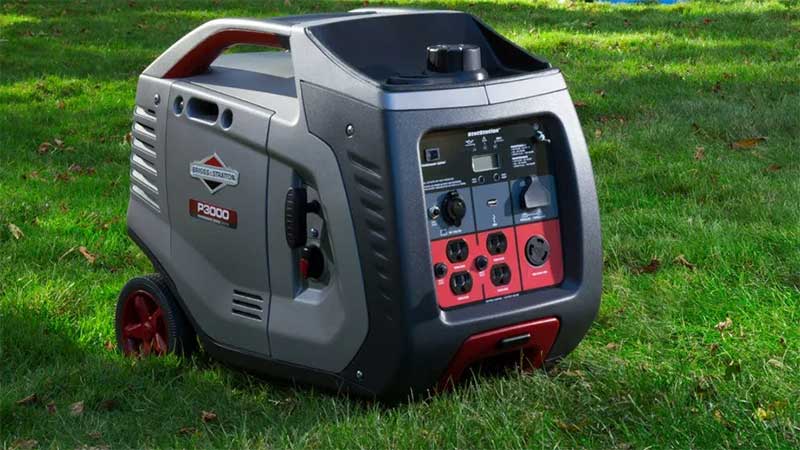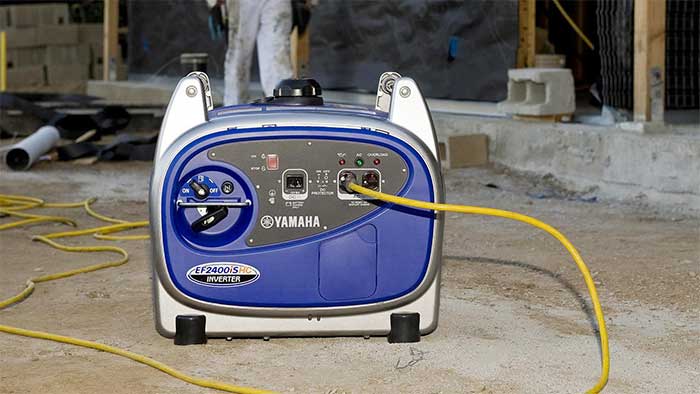Last Updated on August 30, 2023 by kiezelamquiz

Sump pumps are a must-have if you have a basement and are susceptible to flooding.
When your basement floods, it is not an easy task to get the water out quickly. That is what a sump pump is for.
However, if you are dealing with flooding and a power outage, your sump pump may be dead in the water.
In these situations, I get asked, “Can I use a sump pump with a portable generator?”
Portable generators can run sump pumps of all sizes, with a few considerations.
Since you will be working in flooded areas, use caution when using extension cords with your generators. Electricity and water pose the risk of shock, so be aware of your surroundings.
Three Generators to Power a (up to 1/2 Horsepower) Sump Pump
To make things easy, I am going to suggest a couple of generators that will easily power up to ½ horsepower sump pumps.
These generators are tried and true and can be used for just about anything when you are not using them for your sump pump.
1. Champion Dual Fuel Inverter
First up on my list of sump pump generators is the powerful Champion 3400W dual-fuel inverter. This generator allows you to use propane or gasoline as a fuel source for the ultimate versatile generator.
- Starting watts: 3400
- Running watts: 3100
- Weight: 95.7
- Estimated runtime @ 500W Load: 11H 35M

At 3,100 watts, it can easily power the largest of home sump pumps and still have more to power other appliances.
If you need to power larger appliances at the same time, you can hook this generator up to another Champion Dual Fuel in parallel for up to 6,200 running watts.
While this generator does weigh near 100lbs, the integrated handle and plastic wheels allow for easy transporting to anywhere you need it.
It even includes an electric start, which is a great solution for those who struggle with pull cord generators.
2. Briggs & Stratton 30545 P3000
When it comes to small motors, Briggs & Stratton is a household name. With a full line of portable generators, Briggs & Stratton offers a perfectly sized generator for sump pumps.
- Starting watts: 3,000
- Running watts: 2,600
- Weight: 54.6
- Estimated runtime @ 500W Load: 10H 25M

The P3000 pumps out 2,600 running watts, which is enough to power the larger sump pumps and still help with other charging needs during your next blackout. At only 54.6lbs and featuring a telescoping handle and wheels, you can move this generator around with ease.
This portable generator features many outlets, which makes it a great solution for not only sump pumps but a solid home backup energy solution.
Featuring four household 3-prong outlets, an RV hookup, a cigarette lighter outlet and USB plugs, this generator can do just about anything you need it to do.
3. Yamaha EF2400iSHC
Yamaha has made its name known in various industries throughout the years. Most known for their dirt bike and motorsports, Yamaha also has a lineup of generators that carry on their high-quality reputation.
- Starting watts: 2,000
- Running watts: 2,400
- Weight: 82.45
- Estimated runtime @ 500W Load: 8H 35M

Yamaha EF2400iS generator is no different and provides more than enough power for a standard sump pump which means you can use it for cleaning up your flooded basement while also powering other needed appliances.
A built-in smart throttle technology allows this generator to optimize fuel usage and reduce noise volumes for better fuel economy and easier neighborhood usage.
While it is a little on the heavier side, two people can easily carry this generator thanks to the two built-in handles on top.
Unfortunately, this generator is lacking when it comes to outlet selection as it only has a single DC trickle charger and a pair or AC household outlets.
We would have liked to see more outlets, but it is enough to get your sump pump running!
Sump Pump Basics
A sump pump is installed in many basements inside a box-shaped cutout in the floor.
This allows the pump to be at the lowest level and allow water to naturally gravitate to the pump.
Once the pump senses water, it will kick on and start to pump water from the basement to wherever the hose or pipe runs, preferably away from the home.
When you are dealing with conditions that cause flooding, you may run into power outages as well.
This will cause your sump pump to not run, leaving you with a flooded basement. This is where a portable generator can help your sump pump run during a power outage.
A portable generator can be hooked up to your sump pump to help power the pump and remove the standing water.
Since a portable generator can be used whenever and wherever you have fuel, it is a great way to have standby power for your sump pump.
What Type of Generator Can I Use to Run a Sump Pump?
Wondering how to run a sump pump on a generator? Find the wattage demands of your sump pump and then find a generator that will support this power. The higher the horsepower of the sump pump, the larger your generator must be.
For example, a ⅓ horsepower sump pump will have an average starting wattage of 1,300 watts and average running watts of 800 watts.
For ½ horsepower models, you can expect about a 2,150 starting wattage and a 1,050 running wattage.
With these types of wattage numbers, you are going to want a fairly large portable generator. You will want to find a generator that has enough power to run your sump pump, plus a little extra wattage for wiggle room.
This will ensure that your generator is not running at maximum power at all times, which can cause unnecessary wear and premature damage.
Read more about the generator size for running sump pumps here.

How to Install Your Generator
Now that I have discussed types of generators for running your sump pump, let’s take a look at how to install a generator to your pump.
Step 1 – Ensure That Your Generator Is in Good Working Condition
As always, make sure your generator is in good working order.
This includes checking that the generator is clean and free of any defects.
A dirty generator can cause larger problems down the road, so keep it clean. Give it a few test pulls to make sure that it fires up.
The last thing that you want to do is to get it out to where you need it, only to find out that it needs to be repaired or that it is no longer working.
It is a good idea to clean the air filter and check the oil before using the generator to make sure that it is in tip-top shape.
Step 2 – Set Your Generator up at Least 15 Feet Away From Windows/Doors
Portable gas generators use combustion engines to generate power.
This means that the generator is going to be giving off harmful fumes that can harm humans and pets if not properly ventilated. To ensure that the harmful gases do not affect anyone, you have two choices.
You can hook up a rerouting exhaust to your generator or you can simply set up the generator 15 feet away from windows and doors.
If you need to use the generator in a confined space where exhaust fumes cannot be properly ventilated, you can make a generator exhaust to reroute the gases to an exterior area.
These exhausts are relatively easy to make and are a great way to use generators in a garage or under an awning when it is snowing or raining.
If you can put your generator outside, you can simply set it up at least 15 feet away from windows or doors.
This distance will allow harmful gases to dissipate before reaching your home. This can also help to reduce noise levels since portable generators, depending on the size, can be very loud.
Step 3 – Measure the Distance Between the Generator & the Sump Pump to Get the Correct Extension Cord
When connecting your sump pump to the generator, you are going to want to use an extension cord.
An extension cord will help take up the slack between the sump pump power cord and generator and allow you to run electricity from the generator to the pump. Measure or eyeball the distance between the two to figure out what size extension cord you will need.
When using extension cords with generators, make sure you use a high-quality, construction grade extension cord when possible. I suggest these outdoor extension cords by Us Wire (click to buy it on Amazon).
This will ensure that you and your appliances are fully protected from the harmful current of electricity.
Cheaper, low-quality extension cords can overheat and shock you or damage your appliances/generator.
If you are unsure what type of extension cord to use, refer to the portable generator owner’s manual, where you should find recommendations on the correct type of extension cord to use.
Step 4 – Fill Your Generator With Fuel
Before you get your sump pump hooked up and ready to roll on the generator, fill up your generator with fuel first.
While this may seem like common sense, it is a very easy step to overlook when you are in a hurry to save your basement from flooding.
The last thing you want to do once water is flowing out of your basement is to leave your generator to cut off due to low fuel.
Step 5 – Connect the Generator to the Sump Pump
Lastly, connect the generator to the sump pump and ensure that everything is running correctly. With power to the sump pump, you should start to hear the sump pump kick on and notice the water levels decreasing.
You can also check where the sump pump relocates the water to in order to confirm that the pump is doing its job.
You might also want to checkout the Jackery 1500 and learn if it can power your sump pump.
Conclusion
With all of the information I have just discussed on using a portable generator with a sump pump, you should feel ready (though probably not happy) when the next flood comes.
I want to hear about your experience using a generator with a sump pump. What type of generator did you use? What did you find most challenging about using your generator to power the sump pump?

Scott Krager purchased generatorgrid.com in the summer of 2020 and quickly began to buy every generator under the sun! He currently has over a dozen generators and the number is growing quickly. He lives in Portland, OR near his family and friends.
GeneratorGrid.com is an independent review business. I am not affiliated with any manufacturers and do not accept paid reviews. When you buy through my links, I may earn a commission which helps me purchase more generators for testing. - Scott Krager


Glad to see Step 3, I can’t tell you the number of flooded out places I’ve seen because people will drop thousands of dollars on a good quality generator and buy a $20 16/3,100 foot cord from some big box store, and expect them to work when they need it the most, don’t cheap out on the cords, there is no harm in getting a heavier duty cord then you need, and try to stay away from those cords that look like they are a great deal, if it’s a 1/3 of the price of a good cord, odds are good they are not using copper, they are using copper coated aluminum or straight aluminum, just pick them up and feel the weight aluminum is very light and copper it’s heavy and aluminuim or copper coated aluminium cords don’t last any where near as long as a good quality all copper cord.
But I get the reality of why people use cheaper cords, and don’t judge, so If your going to use aluminum or copper coated aluminum cords what ever gauge cord your user manual tells you to use, get them at least 2 gauge sizes larger so it they say 12 AWG get a 10 AWG cord.
And those US wire cords you recommend are good quailty but watch out for knock offs using there name they are no where near the quality, if your ordering online check the shipping weight, a 12/3 all copper cord should be at least 13 lbs per hundred feet 14/3 should be at least 9 lbs / hundred feet of SJTW type wire used by US wire. Other wire like SOOW or SJOW will weigh more.
Aluminum has 61 percent of the conductivity of copper, but has only 30 percent of the weight of copper.